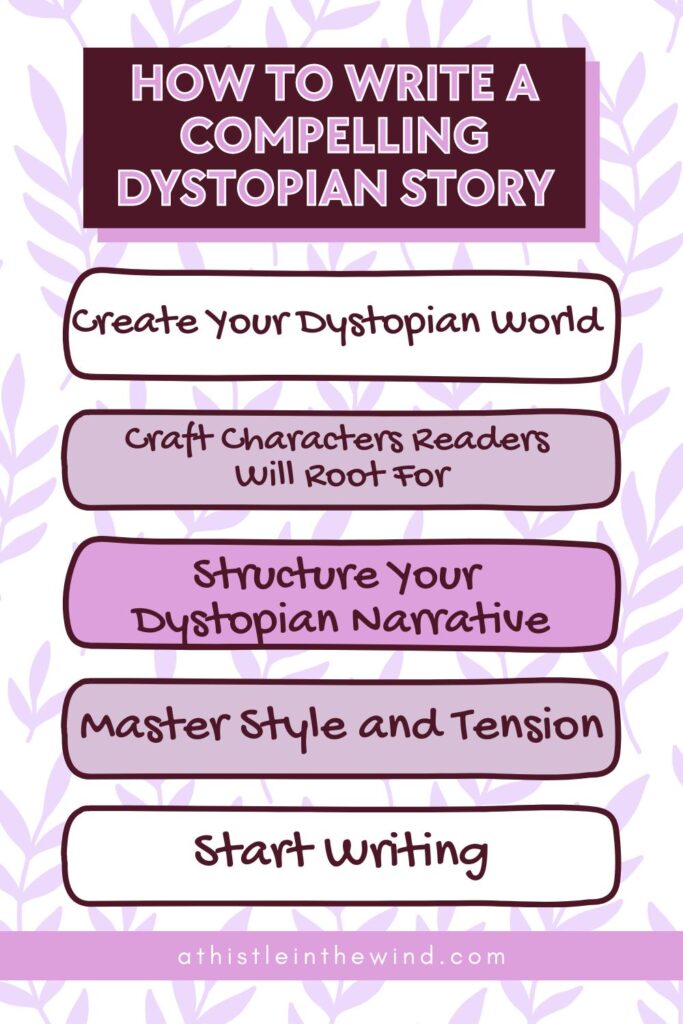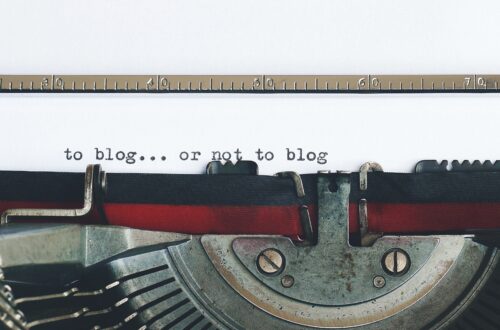How to Write Dystopian Fiction
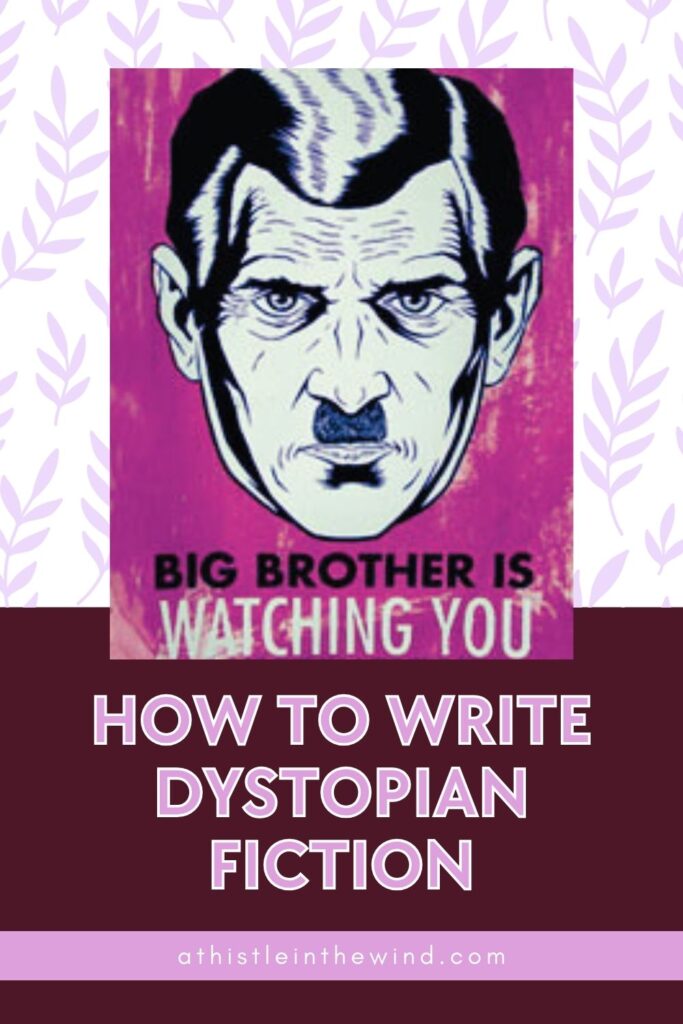
Dystopian fiction is, without a doubt, an amazing genre. It’s not the kind I pick all the time because it’s so easy to mess it up (I’m looking at you, Divergent). But when I do read dystopian books, they quickly end up becoming my favourite books of all time. A classic example of a dystopian story is, of course, 1984 by George Orwell. It’s hands down one of my favourite books of all time, second only to The Alchemist. There’s a lot of science fiction overlap with this genre too. In fact, I’d argue that the Remembrance of Earth’s Past series by Cixin Liu kind of becomes dystopian, especially as the Trisolarans’ invasion threat gets revealed and humanity starts prepping for it. But it’s more skewed towards science fiction.
But that’s the thing about dystopian fiction, it kind of skews in that direction in a bit. Especially if you’re a science nerd like me and the idea of Dyson sphere made you excited in tenth grade. We all have our crosses to bear, okay?
Anyway, the point is, it’s relatively easy to ruin a dystopian story. So, in this blog, I’ll tell you exactly how to write a great dystopian story and how not to muck it up (still looking at you, Divergent. Veronica Roth, you and I have issues). Let’s begin.
What is Dystopian Fiction?
Okay—this one’s for everyone who’s completely confused by what I’m rambling about. Dystopian fiction, as the name suggests, refers to writing a story set in or about a dystopia. And according to Dictionary.com, a dystopia is:
a society characterized by human misery, as squalor, oppression, disease, and overcrowding.
1984, Animal Farm, and The Handmaid’s Tale are honestly the most perfect and in your face example of dystopian fiction. The genre itself can be characterised as a subgenre of speculative fiction. Which is why in the introduction of this blog, I said that I personally characterise the REP series as dystopian. Actually, as much as I hate it, I have to admit that Dune can also be considered a dystopian fiction.
But these stories aren’t just about distant galaxies or impossible technologies; they are about now. They take something real—a fear, a policy, or a behavior—and extend it to its logical, terrifying extreme. When done right, a good dystopia doesn’t feel foreign; it feels uncomfortably close, forcing us to recognize pieces of our current society and imagine what happens if we don’t change course. These are the stories that endure because they reflect the present and challenge us, rather than simply offering escapism.
The Different Types of Dystopian Stories
Before we get into actually writing dystopian fiction, it’s important to understand the type of story you’re writing. I actually found this really helpful article on different dystopian narratives by the Middlebury Institute of International Studies.
So, there are five types of dystopian narratives:
- Pre-emptive victory: Preventable dystopias, cautionary tales that warn us on what could happen if we continue down our current path.
- Conventional victory: Systems that can be resisted and overcome. This is where most popular, young adult fiction stories come in. You’ve got The Hunger Games here, your wizarding stories where the main protagonist defeats the big baddie.
- Conditional defeat: Systems that can be resisted but not overcome completely. The Handmaid’s Tale falls in this category. It offers a more realistic (in my opinion) view of political and societal revolutions where your cast do try to improve things. But because things are so ingrained, it’s difficult to get everyone to just stop believing in something.
- Pyrrhic victory: Systems that cannot be overcome but can be catastrophically destroyed. It requires a complete system overhaul really, and honestly, I think this is the kind of dystopian story my manuscript falls into. Also, as pointed out in the article, there was a popular anti-semetic story (which I will not name here because we’re not about that stuff) that falls into this category but its ultimate conclusion was essentially mass genocide. Lots of religious dystopian fictions seem to be into this type of stuff.
- Comprehensive defeat: Systems that cannot be resisted or destroyed. This is honestly, 1984 in a nutshell. If you’re going to write a story reflecting this type of dystopia—well then, 1984 is the benchmark for this one.

What Makes a Dystopian World Work?
At its heart, a dystopian story explores the antithesis of a utopia. While a utopia is an ideal fictional world where everything works perfectly, a dystopia shows a society in cataclysmic decline where life is hard, people suffer, and freedom is rare.
The destruction of society can stem from totalitarian rule, environmental ruin, technological control, war, disease, injustice, or suffering.
So, when writing a dystopian, your primary goal is to create a dark and broken world that acts as a stark warning about the future. But for that warning to hit hard, the world itself needs to feel real and ruthlessly logical.
1. Start with a Rupture, Not a Concept
One of the most effective ways to build a compelling dystopia is to prioritize the story over the grand concept. Sometimes, writers start with an incredible idea, like, “What if a religious totalitarian regime treats women like livestock?” like The Handmaid’s Tale. These are great starting points, of course, but you have to follow it up with a story that ropes people in.
Instead of beginning with the overarching political theme, start with the moment the world cracked: the rupture. This could be a political decision, a cultural shift, a natural disaster, or a technological breakthrough that promised convenience but delivered control.
The world doesn’t change with something dramatic; it crumbles through silence, small compromises, new laws that go unnoticed, and technologies that people welcomed without understanding the terms.
From that initial wound, you can grow a society that believes it is functioning or even thriving, but only at a terrible cost. The way people live, move through public space, speak, and even what they eat should all feel shaped by that original systemic flaw.
2. Building a Backstory That Justifies the Bleakness
A believable dystopian future needs a convincing history. You need to determine how your society became so bleak and uncertain. What was the first foreshadowing of things to come? What was the turning point in history when hope was lost or people stopped fighting back?
Totalitarian regimes may be inhumane, but they are usually ruthlessly efficient. If your society’s rules and traditions seem arbitrary, readers won’t be able to suspend their disbelief. You need to be able to fathom how this villainous government functions and holds power long enough to subjugate its citizenry.
A strong backstory provides the logical chain of cause and effect necessary to make your worst-case scenario feel plausible. For example, in 1984, the world war divided the globe into three superstates, creating the context for Big Brother’s omnipresent surveillance. Knowing this history helps you figure out exactly how the system works.
3. Draw from the Real World
The most terrifying societies are those that have a foothold in logic derived from the world around us. Why invent a terrifying oppressor from scratch when you have countless examples of flawed societies, both current and historical, to study?
Margaret Atwood famously said of The Handmaid’s Tale that she didn’t include anything that hasn’t already been done, is being done, or is seriously being tried, coupled with trends already in progress. The amount of pure invention was close to nil. This grounded approach is why the story hits so hard.
To identify your central conflict, examine the present. Identify an issue that could lead to terrible consequences if left unchecked—perhaps the melting ice caps, excessive screen time, or the rise of a political extreme.
- Extrapolate the Problem: Once you choose an issue you’re passionate about, ask yourself what the absolute worst thing that could happen from this problem is, and then multiply it by ten.
- Use History: If you need an ancient ceremony or ritual for your story, look to real traditions, like Shirley Jackson pulling from ancient harvest sacrifices for “The Lottery.” If your future America forces women to bear children, as in Gilead, remember that this practice echoes past civilizations like biblical times or Ceaușescu’s Romania.
By doing your research and thinking your ideas through to their logical ends, your strange and terrifying society will hang together with more than just force of will.
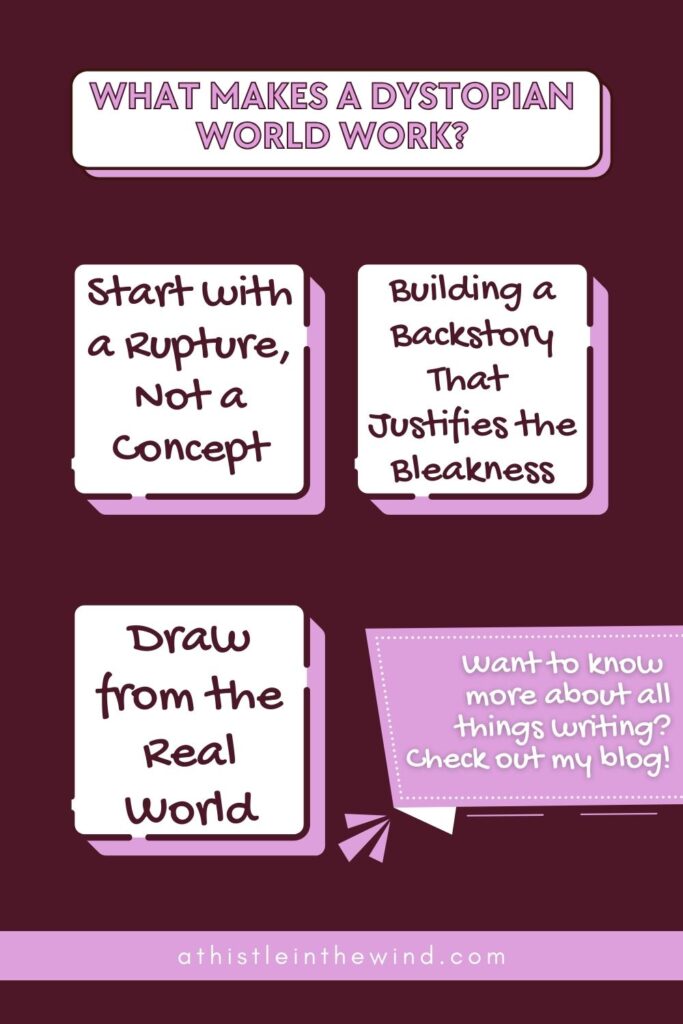
The Essential Elements of Dystopia
To ensure your novel has the complexity and resonance of the genre greats, make sure you incorporate the five core elements that define successful dystopian fiction:
1. Worst-Case Scenarios
Great dystopian stories don’t tread lightly. They take our anxieties and fears and turn them up to eleven. Whether you are worried about climate change leading to disaster (like the thinly-veiled conceit in the film Don’t Look Up) or technological progress leading to time-traveling cyborg assassins (like The Terminator), a powerful dystopian story pulls the problem apart like an onion, forcing readers to consider complexities from differing angles.
2. Dramatic Conflict
Due to the nature of the genre, the obstacles facing your protagonist are guaranteed to be huge, with life-or-death stakes. The external conflicts, like character vs. society or character vs. technology, are inherently strong. Layering the character’s internal conflicts—their philosophical stances and clear, difficult choices—on top of the external fight grounds the story in reality.
3. Inventive Worldbuilding
Your apocalyptic scenario must be reflected in your world. If you have a totalitarian government, how is that reflected in the clothes, diet, and living conditions of civil servants versus the general public? Is the difference shown through extreme poverty or homelessness for the populace? This meticulous world-building ensures the story feels authentic.
4. Thematic Resonance
The broadest dystopian themes revolve around destruction, the abuse of power, and survival. Destruction can be technological, nuclear, or environmental, resulting in mass poverty and violence. Abuse of power, often governmental, includes censorship, extreme oppression, and loss of personal or cultural identity. Survival becomes the goal, whether physiological (air, food, shelter) or psychological (mental health).
Dystopian themes can take on significance during periods of upheaval, galvanizing real-world opinions and impacting future decisions. This is why 1984, published in 1949, became a sudden bestseller decades later. Your story should address the issues that are top-of-mind in the cultural consciousness.
5. Humanity as Good or Evil (Or Both)
Dystopian fiction is an excellent vehicle for making the pitfalls of human duality scarily clear. You get to choose who is on the side of good, evil, or neither. Is your protagonist a hero, an anti-hero, or perhaps a closet villain?
Human beings are complex, capable of rational thought but often fueled by emotion. The themes explored—like the idea of whether humanity is essentially evil, as seen in Lord of the Flies—allow for deep exploration.
The best dystopian stories often strive to show the power of the human spirit and its enduring potential. Characters labor through long, painful journeys, and that struggle makes their eventual success so fulfilling. Triumphing over adversity is inspirational, and these stories stay with us long after we finish reading.
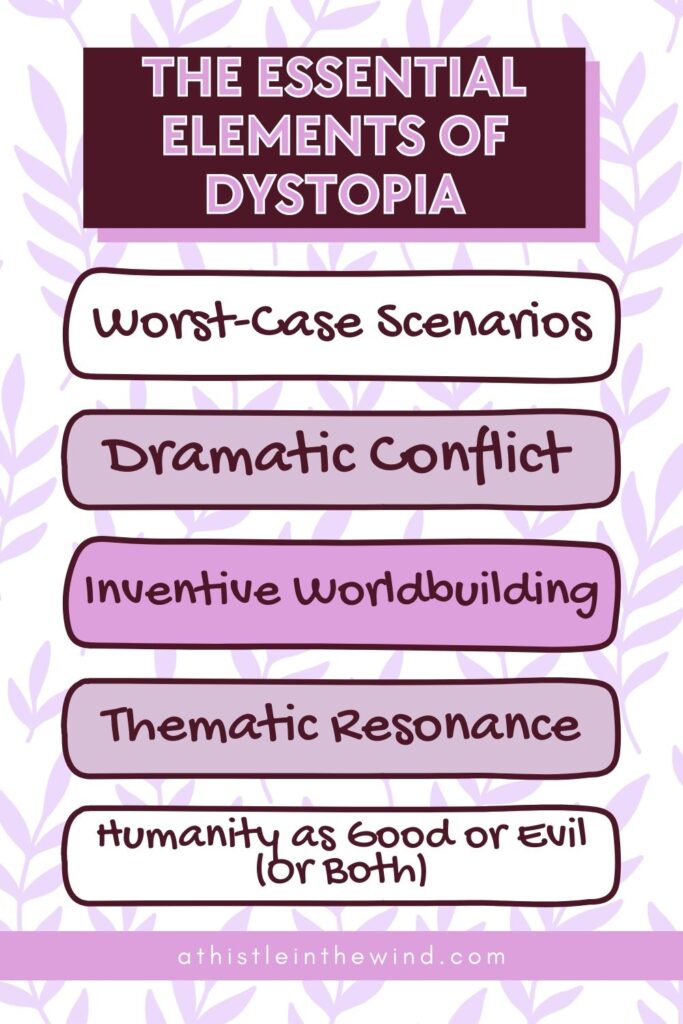
How to Write A Compelling Dystopian Story: A Step-by-Step Guide
So, now that you have a general idea of what dystopian fiction is and how you can make it work, let’s get into the nitty gritty details on how you can actually write it.
Step #1: Worldbuilding: Creating Your Dystopian World
Unlike other genres, when writing dystopian fiction, you really need to ensure that your wordbuilding is done in advance, and that you have a clear idea of what’s happening. This is actually something I had to learn to do. And that’s because dystopian worldbuilding is where the premise and conflict fuse together. The setting is not just a backdrop; it’s an active presence in the story that shapes your characters, plot, and tone.
The Role of Society and Government
Dystopian governments almost always take the form of a totalitarian regime or a dysfunctional society that controls every aspect of life. This control is maintained through fear, propaganda, and strict laws.
Living under such a regime has profound psychological and sociological consequences.
- Psychological Impact: Constant fear and lack of freedom lead to mental distress, anxiety, and a profound sense of helplessness. The protagonist struggles deeply with their sense of identity and autonomy, often feeling trapped.
- Sociological Impact: Trust becomes rare, and paranoia is common. People become isolated, and community bonds weaken, because trusting others is simply too dangerous.
Technology and the Eye of Control
In a dystopian novel, technology is rarely liberating; it is usually used by powerful groups to monitor and manipulate the population. The goal is to enforce conformity and punish individualism.
- Surveillance: The constant state of monitoring destroys privacy and makes rebellion nearly impossible. In 1984, Big Brother used technology to watch everyone all the time. When people know they are always being watched, it creates fear and obedience.
- Conditioning: Technology can control life from birth to death. In Brave New World, citizens are conditioned to be content with their predetermined roles, and dissent is quickly suppressed.
The psychological struggle here centers on the loss of privacy and personal freedom. Characters cannot express their true thoughts or feelings, leading to isolation.
Environment and Geography as Metaphor
The physical world should reflect the broken state of society. Harsh, uninhabitable environments are powerful symbols of humanity’s degradation and despair. If the world is a barren wasteland, as in The Road, the bleak landscape mirrors the characters’ hopelessness. This environment forces characters into survival mode, increasing stress and leading to difficult moral choices and a potential loss of humanity.
Sociologically, these harsh settings can either divide people further, with groups turning to violence, or force them to bond together against a common threat. For example, the father and son in The Road bond through their struggle, while others resort to cannibalism.
Want to learn more about worldbuilding? Read my blog: On Writing Revolutions: The Ultimate Guide for Writers.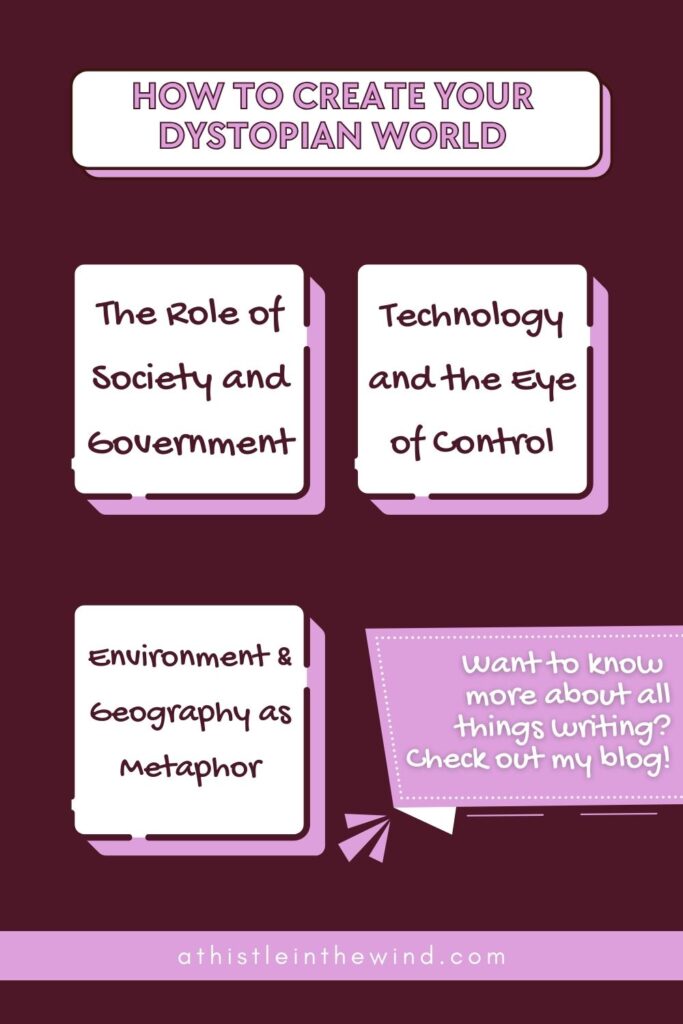
Step #2: Character Development: Creating Characters Readers Will Root For
You may have built the most terrifying, logically flawed society ever conceived, but without a compelling protagonist, the story won’t stick.
When people describe their favorite dystopian stories, they often focus on the setting but the story is the heart. You need that want, that connection, to keep readers reading.
The Evolution of the Protagonist
Your protagonist often begins as a part of the system or at least resigned to it. They are not heroes from the start. The story begins when they notice a small crack: a rule that makes no sense, a person who disappears, or a forbidden feeling. This small crack spreads, turning doubt into discomfort, discomfort into resistance, and resistance into action.
They don’t necessarily need to save the world, or they may find that they cannot. Their act of rebellion is often simply choosing to see clearly in a world built on lies.
As the protagonist moves through the story, they must overcome the oppressive government, invasive technology, and the harsh environment. Their psychological struggle involves finding hope and strength in a seemingly hopeless world. This journey can lead to significant personal growth and a deeper understanding of freedom and humanity.
Personal Stakes Always Outweigh Political Ones
This is crucial: have your heroes care about something besides the broken system. If the sum of your character is just their desire to overthrow the extremist regime, the book will feel shallow. Readers empathize when characters have needs that are personal as well as political.
Focus on what they long for—maybe it’s memory, love, or silence. That longing makes them undeniably human, and in a dystopia, humanity is always the most dangerous thing.
- The Power of Connection: In The Handmaid’s Tale, Offred undoubtedly wants Gilead overthrown, but she also desperately misses her husband and daughter and wants to know what happened to them. She even has seemingly petty wants, like missing hand lotion and trying to use butter as a substitute.
- Protection and Survival: Katniss Everdeen from The Hunger Games doesn’t initially set out to be a revolutionary symbol. She simply wants to survive and protect her loved ones—a universally relatable instinct.
- Personal Loyalty: In Yoko Ogawa’s The Memory Police, the narrator lives in a society where citizens have accepted their amnesia-inducing oppressors. The system isn’t her main concern; instead, she worries about the welfare of her friend, whom she hides under her floor when he becomes a fugitive.
Remember: Love bests politics every time. Granting your protagonist a universally relatable goal allows the reader to connect with them on an emotional level and become invested in their fate.
Defining the Forces of Opposition
The antagonist typically represents the oppressive system or its direct agents. Whether it’s Big Brother in 1984 or President Snow in The Hunger Games, this entity creates the main conflict and must be powerful, manipulative, and a real threat to the protagonist’s goals.
- Determine Who is in Power: Figure out who the leader is, how they usurped or increased control, who benefits under this reign, and, crucially, who suffers the most. Power dynamics are often at the center of the story, providing the conflict.
Allies, Mentors, and Traitors
Supporting characters are essential to provide different perspectives and challenges.
- Support: Friends and allies provide hope and strength. Moira in The Handmaid’s Tale is a key friend who offers the protagonist resilience.
- Tension: Traitors add complexity and uncertainty. They may appear to be friends but later reveal their loyalty to the system. O’Brien in 1984 pretends to be an ally in Winston’s rebellion but is, in fact, a loyal enforcer of the Party. In the world of dystopia, the mentor might be part of the system, and the safe place might be a trap.
Want to learn more about writing characters? Read my blog: How to Write More Likeable (or Unlikeable) Book Characters.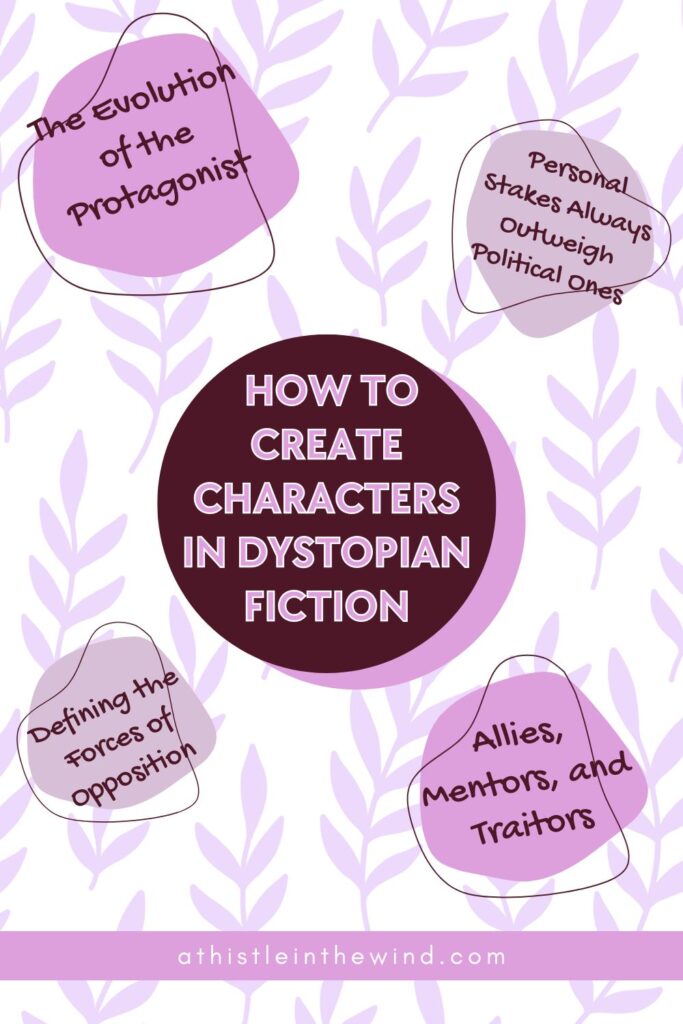
Step #3: Outline Your Plot: Structuring Your Dystopian Narrative
A dystopian plot is often built slowly, patiently, like a pressure cooker. It begins in apparent stability, with life seeming to go on—the trains run, the lights shine—but underneath, there is rot.
1. Introduction: Setting the Stage
The start of your novel sets the stage by introducing the reader to the dystopian world. This phase provides essential background information about the society, its rules, and the oppressive system.
You need a strong hook that highlights your unique premise and what it means for the world. You also need to introduce your protagonist and how they fit (or don’t fit) into the world, leading quickly to the inciting incident.
In Divergent, the story begins by explaining the faction system—society is divided into distinct groups with specific roles—allowing the reader to understand the societal structure and the personal conflict the protagonist faces when she struggles to fit in.
2. Rising Conflict: Pushing the Boundaries
This phase introduces the main issues and challenges. The protagonist begins to see the flaws and question the status quo. As they start to ask questions and push boundaries, the world reacts; the system defends itself, first through warnings, then through punishment. Once the protagonist crosses that line and chooses resistance, there’s no going back.
In The Handmaid’s Tale, Offred finds small ways to assert her independence, forming secret alliances and preserving memories of her past life. These small acts of defiance build tension and highlight the oppressive nature of Gilead.
3. Climax: Confrontation Without Illusion
The climax is the turning point, a moment of high stakes and intense emotion where the protagonist confronts the main antagonist or oppressive system. Crucially, the climax isn’t necessarily about defeating the system; it is about confronting it and seeing it fully, without illusion.
John the Savage challenges the World State’s values in Brave New World, rejecting conformity and shallow pleasures. This dramatic confrontation forces both John and the society to face their core beliefs.
4. Resolution: Hope, Tragedy, or Uncertainty
The resolution wraps up the story, and in dystopian fiction, this can take a few forms.
- Conclusive Ending: The protagonist achieves some victory, perhaps escaping, overthrowing the regime, or finding personal peace. The Hunger Games ends conclusively, as Katniss’s actions lead to the collapse of the Capitol, providing a sense of closure and hope.
- Open-Ended Finish: Questions are left unanswered, leaving readers to ponder the future. 1984 ends with Winston’s fate uncertain, which powerfully reflects the Party’s enduring power.
Regardless of the tone, the ending must be believable. If you opt for a happier note, refrain from making it too happy; it’s generally unrealistic for one protagonist to overturn a dystopian reality single-handedly. Instead, aim for achievable goals, such as finding love or hope in dire circumstances, or taking the very first step toward a better future. In The Road, the father dies, but the survival of the son, who is taken in by a new family, suggests that goodness still exists and society might manage to rebuild itself.
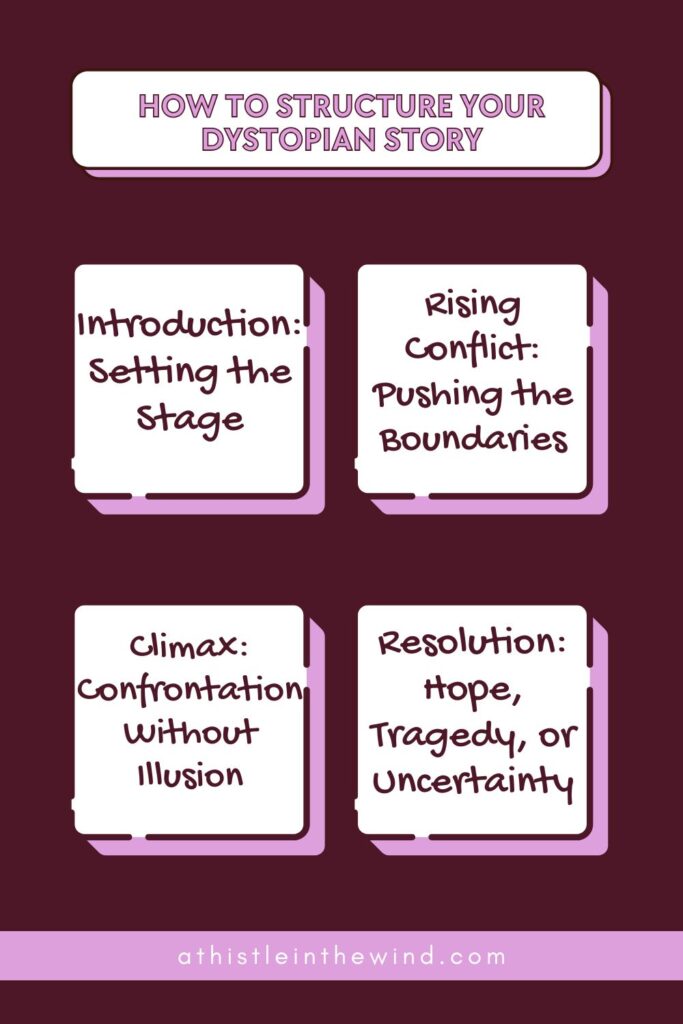
Step #4: Determine Your Approach: Mastering Style and Tension
To create a dystopian book that stays with the reader, you need to use specific techniques that heighten the tension and atmosphere.
The Power of Language
One of the most brilliant tools in dystopian fiction is language, because if you can change how people speak, you can change how they think.
Think carefully about the words your characters use:
- What do they call the government?
- How do they talk about love, death, or freedom?
- What are they no longer allowed to say?
When speech is regulated, silence becomes resistance and every line of dialogue carries significant weight. Authors like Orwell invented Newspeak, and Atwood used rigid titles like Handmaid and Commander. In A Clockwork Orange, Anthony Burgess used the fictional slang Nadsat to reshape how we understand violence and youth culture. Authentic dialogue should reflect the conditioning and societal values of the world, reinforcing themes of control and conformity, as seen in Brave New World.
Tone and Description
The tone should generally be dark and oppressive, reflecting the harsh reality. To achieve this atmosphere, focus on the characters’ fear, desperation, and struggles.
Use detailed descriptions and sensory input—what the world looks, sounds, smells, and feels like.
- Atmosphere of Control: In 1984, the dreary streets, rundown buildings, and omnipresent propaganda posters contributed powerfully to the sense of control and surveillance.
- Stark Contrast: Use setting details to highlight inequality. In The Hunger Games, the contrast between the luxurious Capitol and the impoverished districts is stark, helping readers visualize the stakes.
- Bleakness: The somber tone and use of short, simple sentences in The Road convey the harshness of the desolate landscape and constant danger.
Using Twists to Deliver Ideological Punches
Twists and surprises are essential for maintaining tension and keeping the reader engaged. They create a sense of unpredictability and excitement. Crucially, the most powerful twists don’t come out of nowhere; they emerge from truths the reader almost suspected but didn’t want to believe.
Twists in dystopian fiction should be ideological punches that remind the reader that trust is dangerous, hope is fragile, and control can wear many masks. They must deepen, not derail, your themes.
- Shocking Revelations: These alter the reader’s understanding of the entire story. For example, in The Maze Runner, the characters discover the maze they are escaping is actually part of a larger experiment.
- Unexpected Betrayals: Betrayal adds emotional depth and complexity. O’Brien’s revelation as a loyal enforcer, not an ally, in 1984 heightens the tension around themes of trust and control.
- Hidden Agendas: Characters who appear simple may have complex roles. Nick in The Handmaid’s Tale initially seems a simple chauffeur, but his true role as a resistance member adds layers of complexity to the plot.
- Unforeseen Consequences: When a protagonist’s decision leads to unexpected, large-scale results, it deepens the theme. Katniss’s act of defiance in The Hunger Games sparks a much larger rebellion than she ever anticipated, advancing the plot based on unintended consequences.
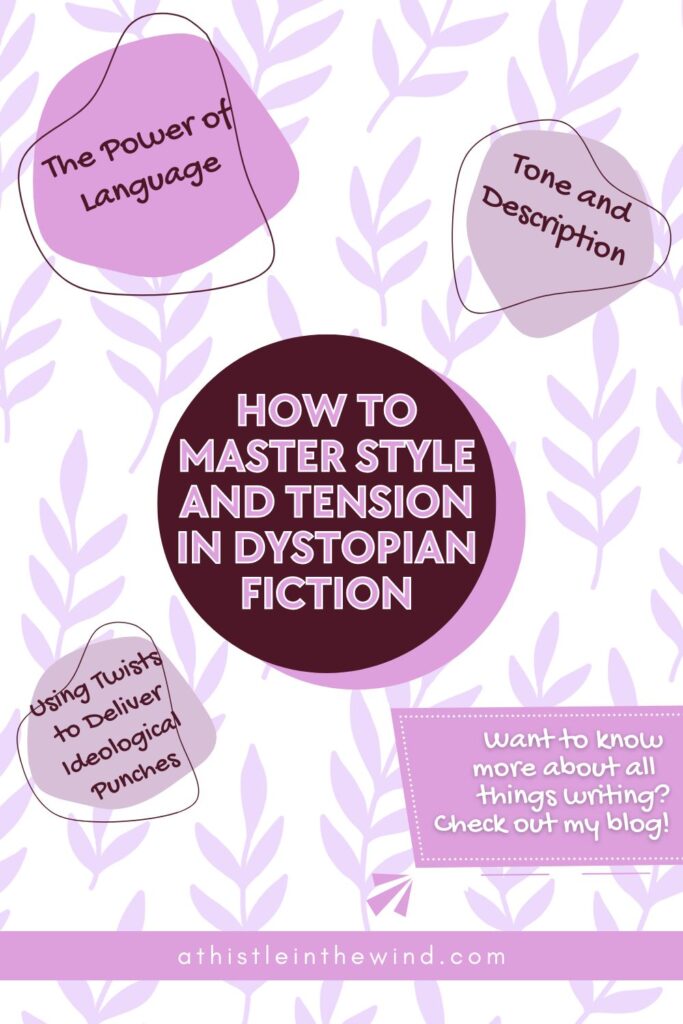
Step #5: Start Writing: Five Key Steps to Getting Started
Writing a dystopian novel can feel daunting especially if you look at the examples in the genre. But the process isn’t that hard if you break into little segments to get started.
1. Choose Your Problem
Start by choosing the issue or theme that you want to explore. For many dystopian authors, the initial idea arises from real life. What issues happening around the world make you angry? What matters deeply to you?.
- Example: Margaret Atwood’s idea for The Handmaid’s Tale came from a conversation in the 1980s about what would force women out of the home.
- Example: Dave Eggers was inspired by data tracking and privacy concerns for his novel The Circle.
Scour the news and current affairs for meaningful inspiration.
2. Make It a Compelling Premise
You’ve chosen your problem—now flesh it out. If you are struggling to translate your problem into a premise, you might be thinking too small. Don’t just go big, go gargantuan! Tease out the knock-on effects that will make your premise real.
If your problem is inflation, the absolute worst-case outcome might be a society where only certain people have access to basic utilities like electricity and gas. You then explore the why and the how. What does the difference look like? Do the “have-nots” use fire, and what does that mean for the environment? These consequences make the premise authentic.
3. Choose Your Protagonist
Think about the traits and skills your protagonist should possess—or learn—to navigate this terrifying world. Do you want your main character to achieve victory, or is your aim a cautionary tale, like 1984?
Remember the burden of the dystopian world on their shoulders, and don’t forget their support system. They will need allies to challenge them and help them along the painful, long journey.
4. Check Your Conflict Strength
Dystopian novels fall into the category of external conflicts: character vs. society, technology, or nature. Since your antagonist is often the entire system, your conflict is inherently strong, dealing with life-or-death stakes.
Ensure the core conflict is powerful enough to carry the story. Remember this formula:
your character’s want + its obstacle = conflict.
A strong central conflict forces your protagonist to reveal themselves through the constant actions and decisions they must make.
5. Build Your World Details
While you’ve been brainstorming, you’ve likely made notes on the world, but this is the phase for detailed structuring. Building your story to life means exploring every element of the dystopian setting:
- Physical World: Nature, geography, climate, seasons, resources, and plants/animals.
- Population: Races, genders, sexualities, and classes.
- Governance and Culture: Language, religion, norms, values, and economic systems.
Well-crafted settings make fictional worlds feel authentic. Use this inventive worldbuilding to reflect and build upon your story’s big themes.

Let Your Story Resonate
Dystopian stories offer a powerful experience, guiding us and teaching us where to do better in the hope of a better future. They challenge us to think critically about our current world and the consequences of our choices.
Writing a dystopian novel is demanding; you aren’t just telling a story, you are building an entire system, and then tearing it apart. By focusing on crafting a logical, believable world built on real-world concerns, developing characters whose personal stakes are heartbreakingly high, and structuring a plot that builds tension slowly and deliberately, you can create a truly memorable novel.
Remember, freedom is fragile, truth is precious, and silence is never neutral. The compelling dystopian novel not only entertains but serves as a powerful social commentary.
